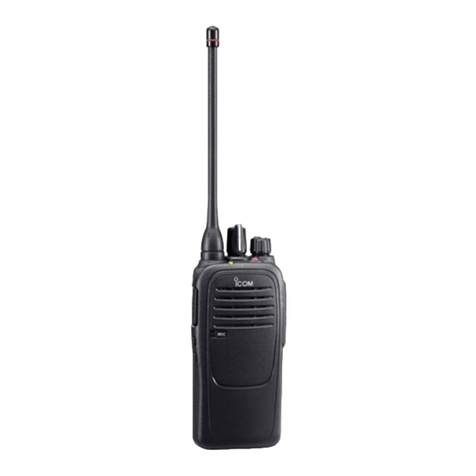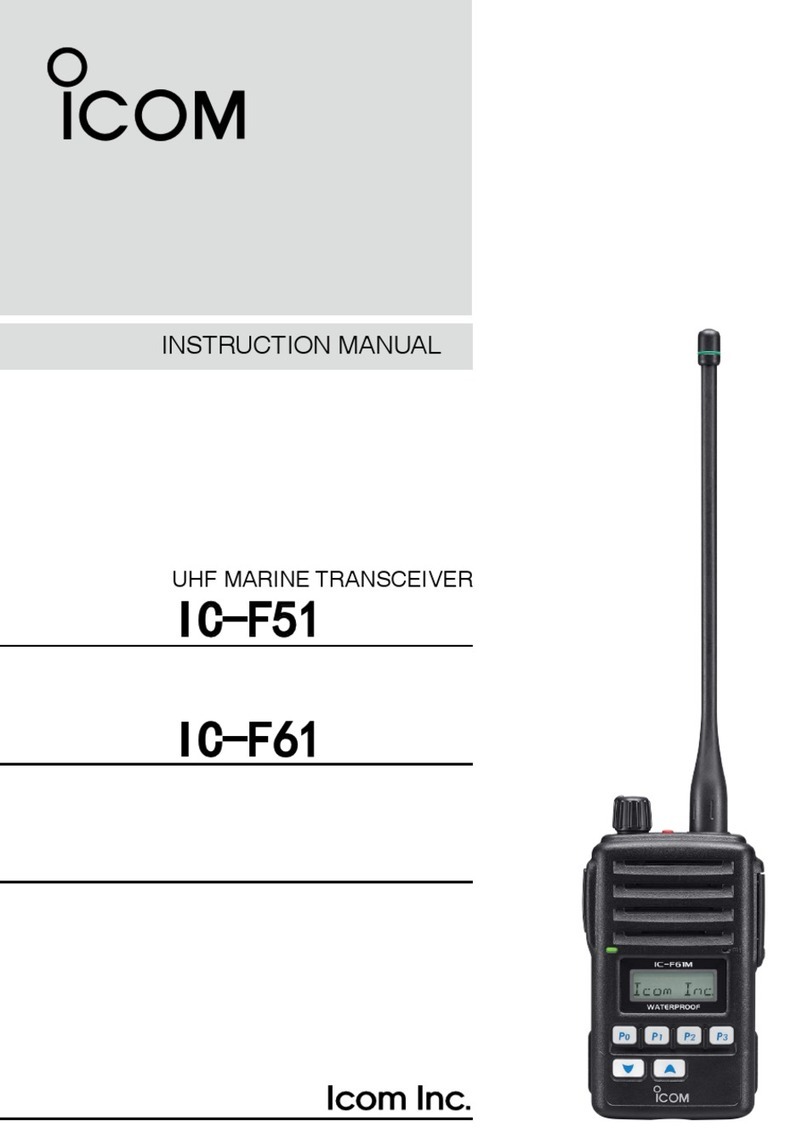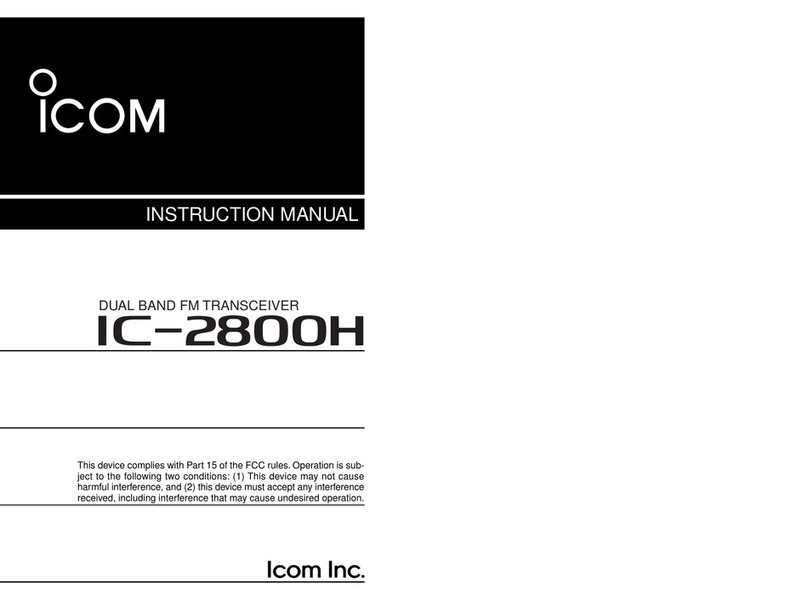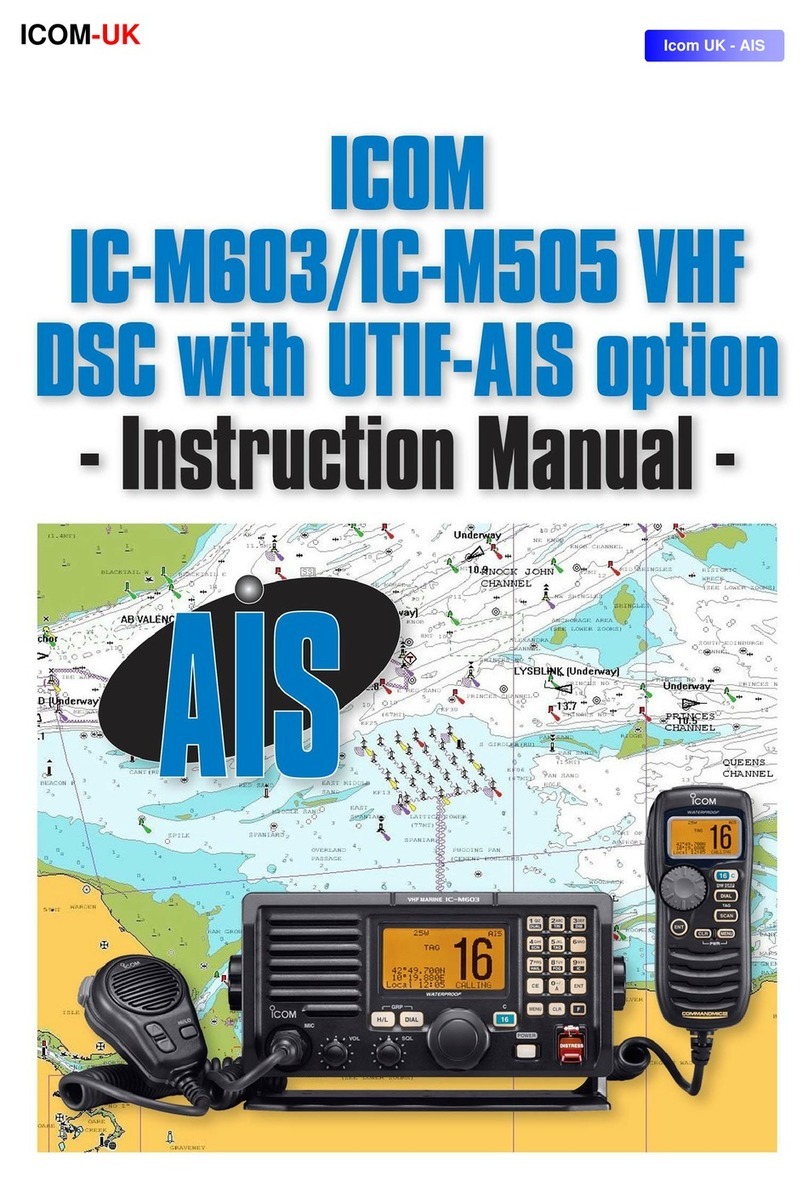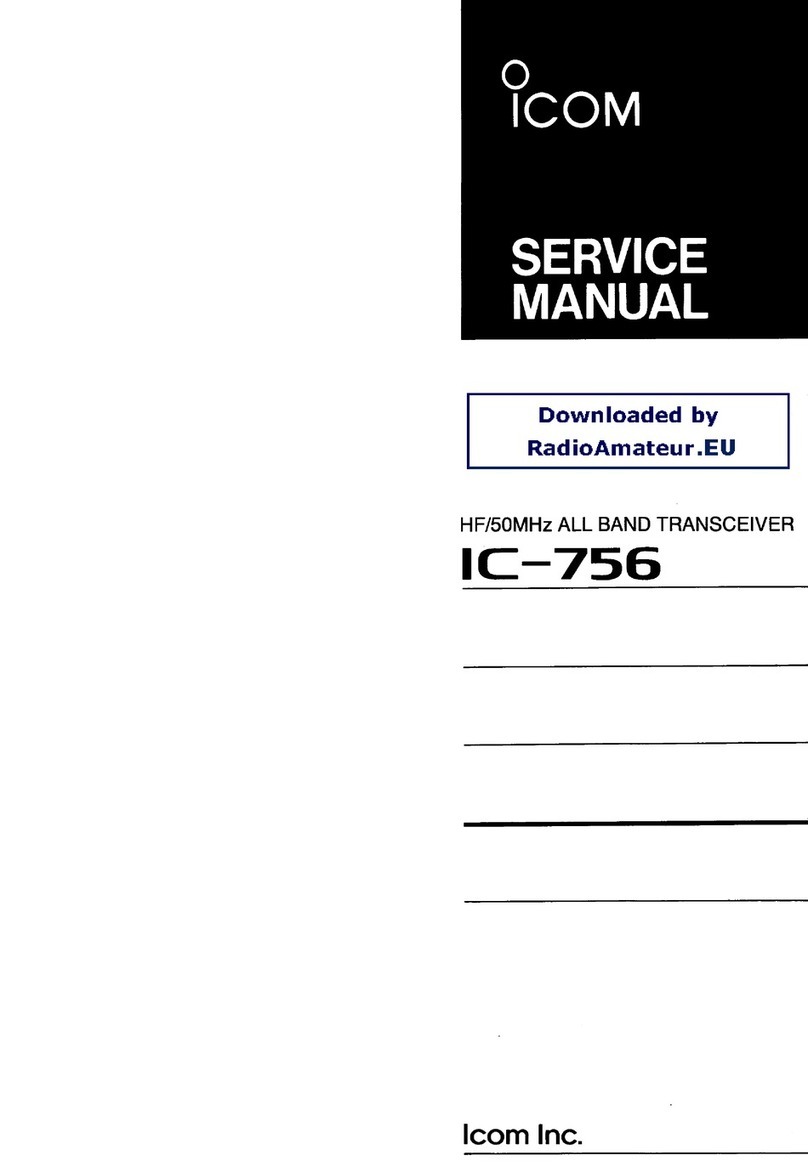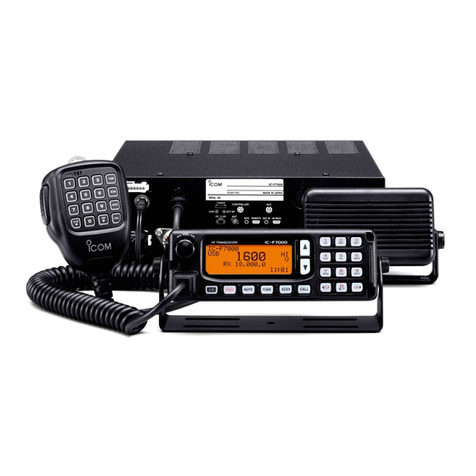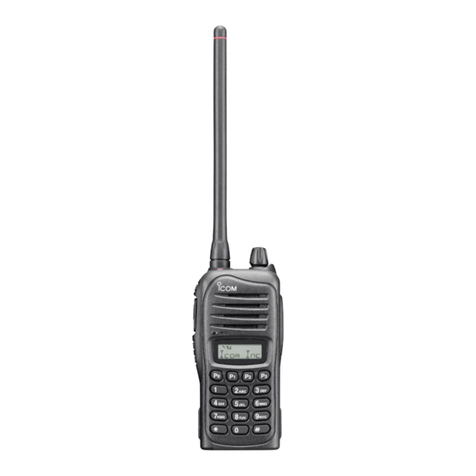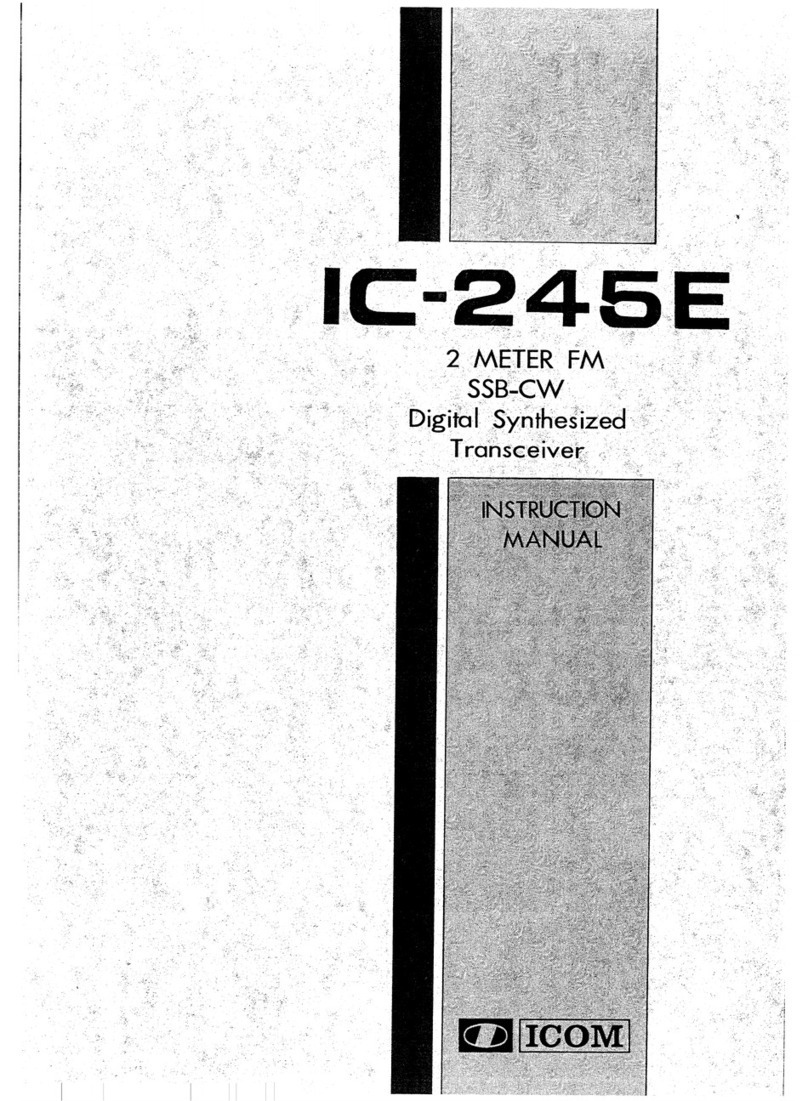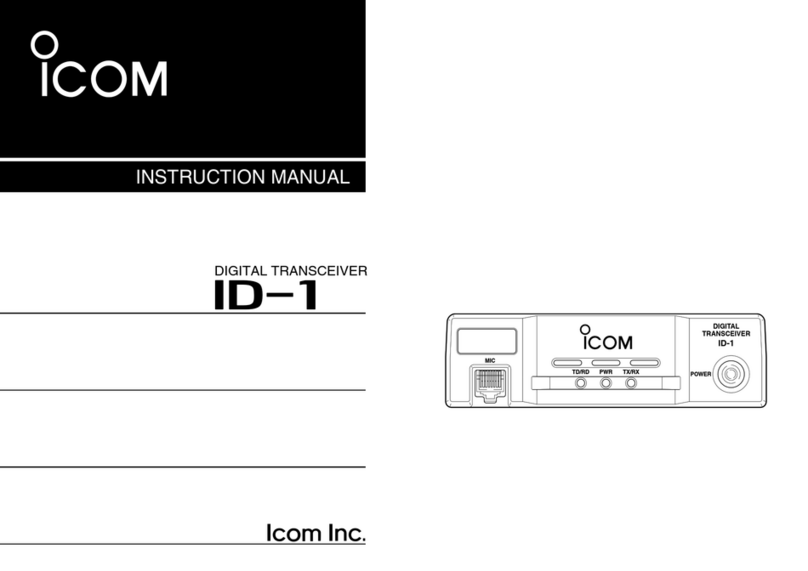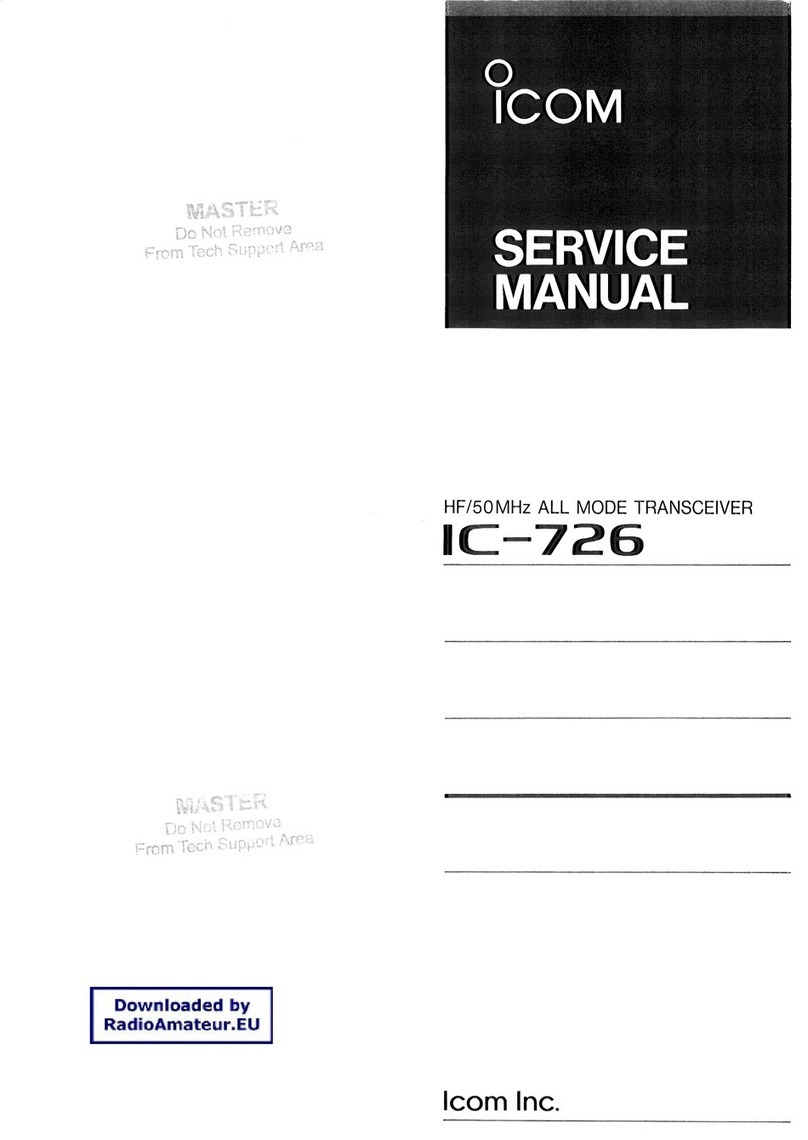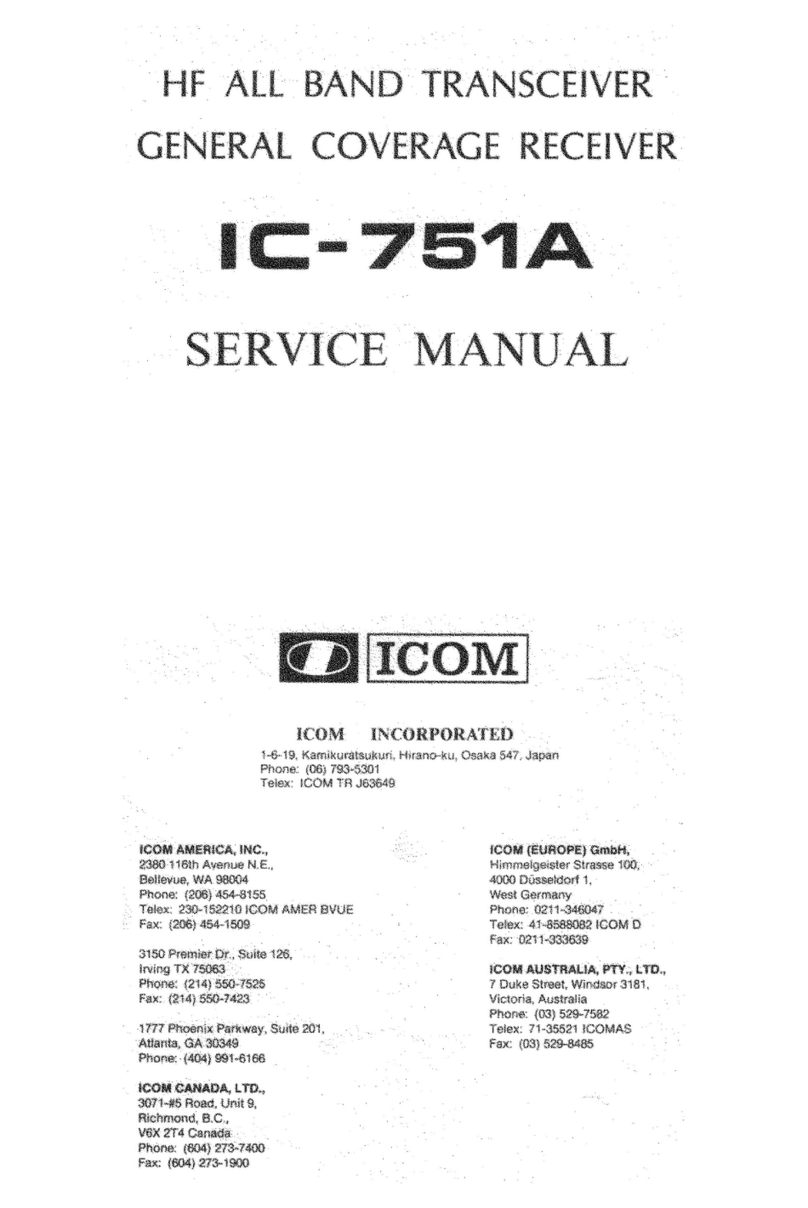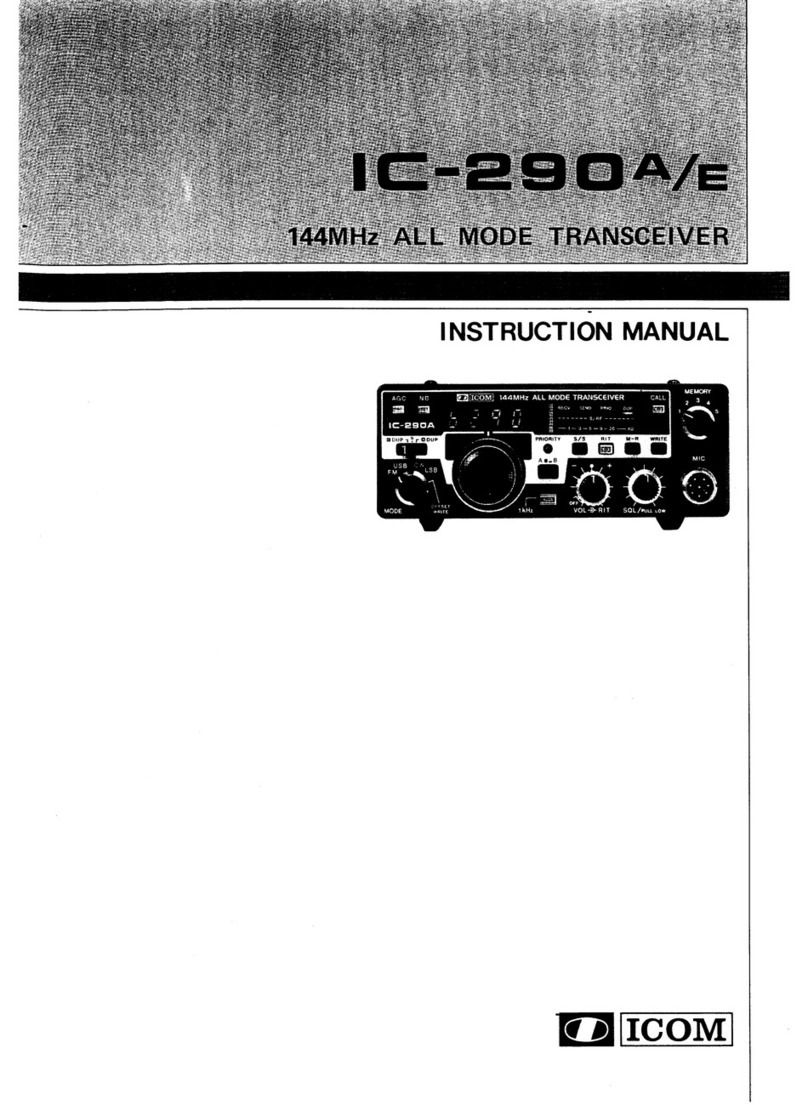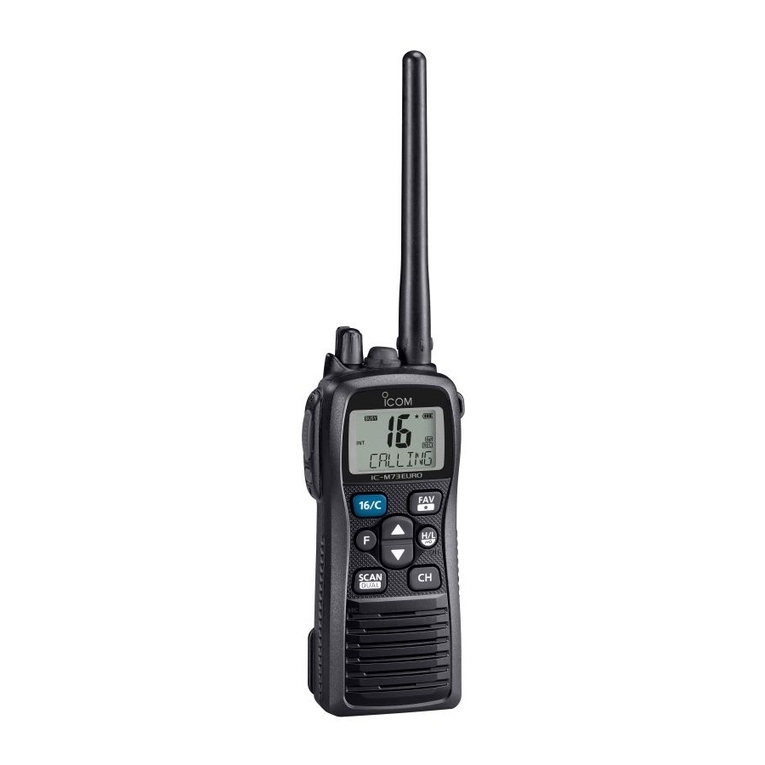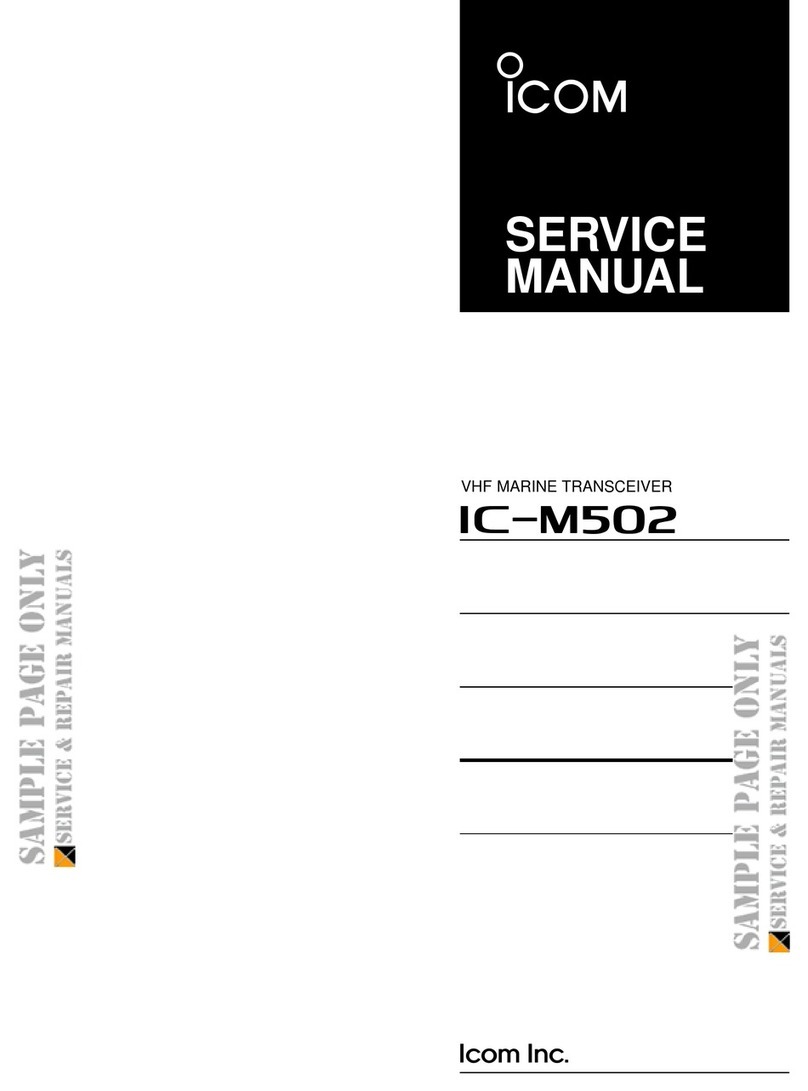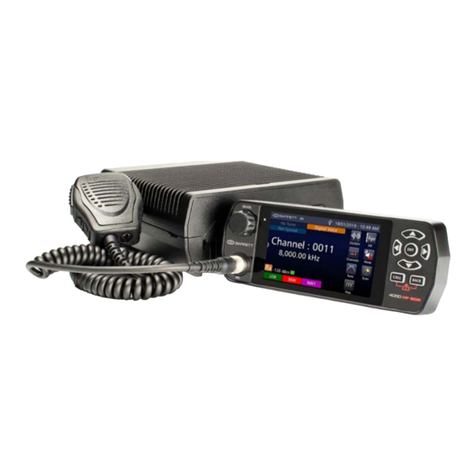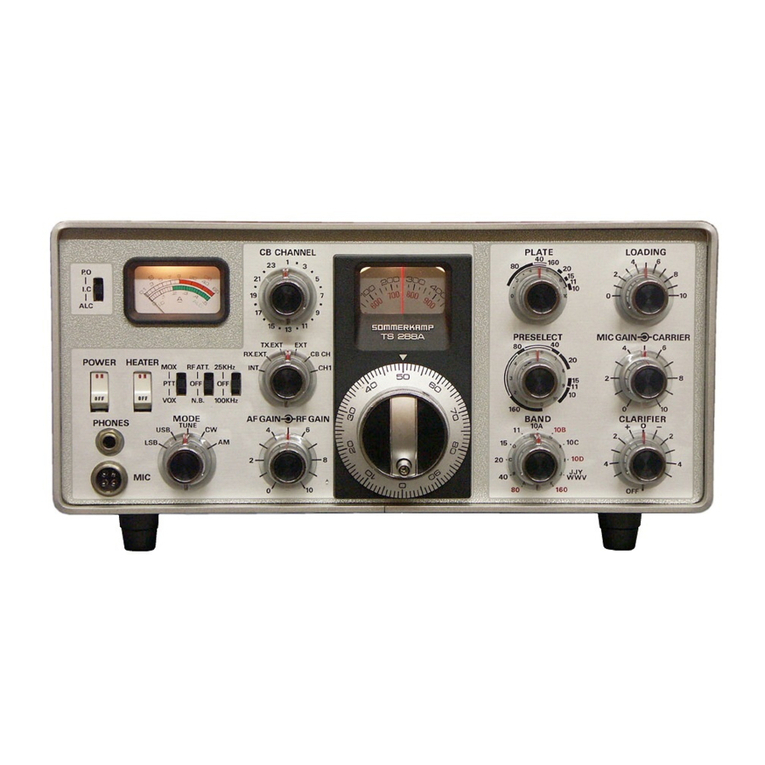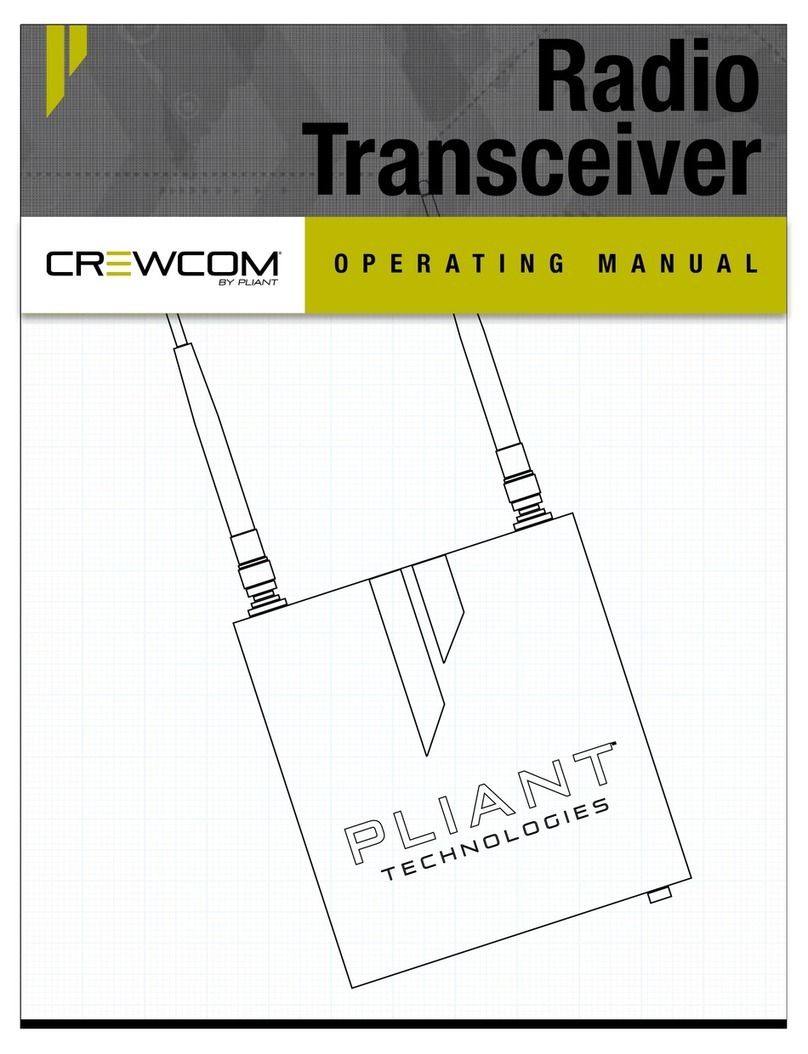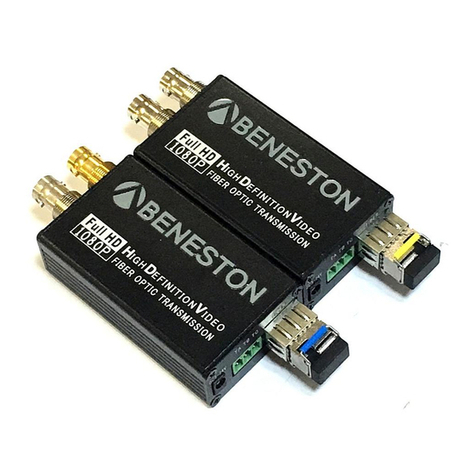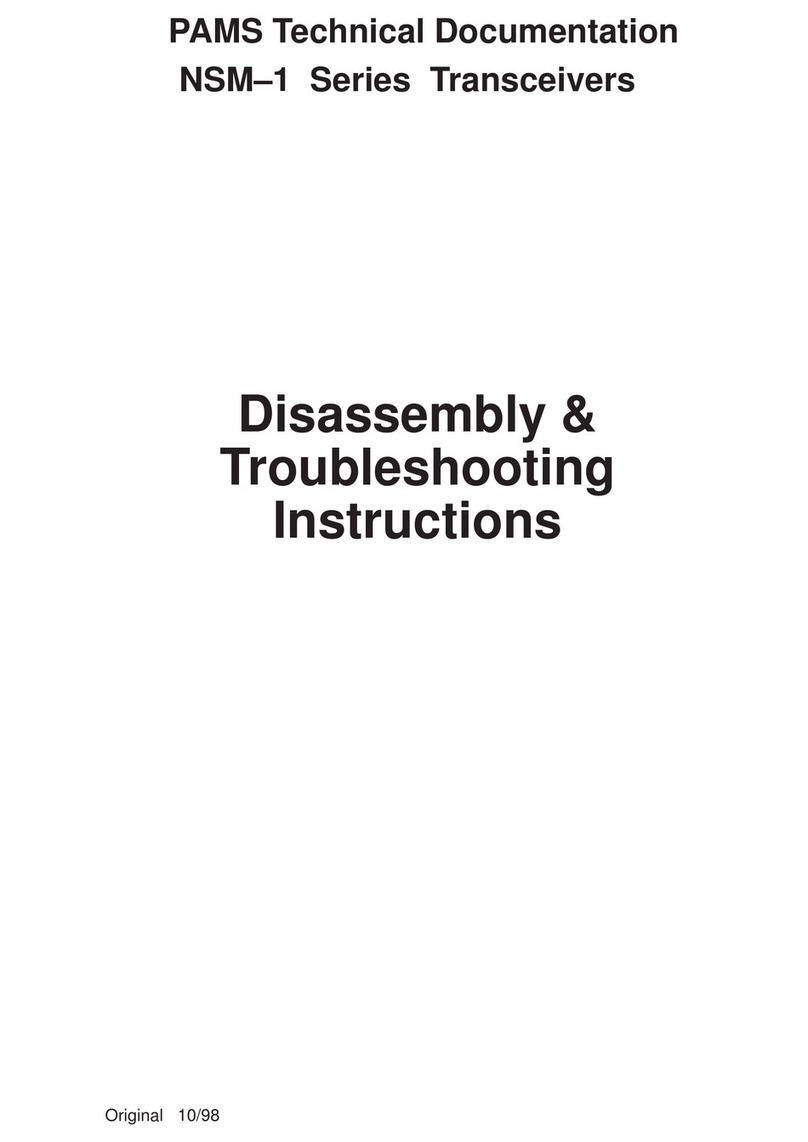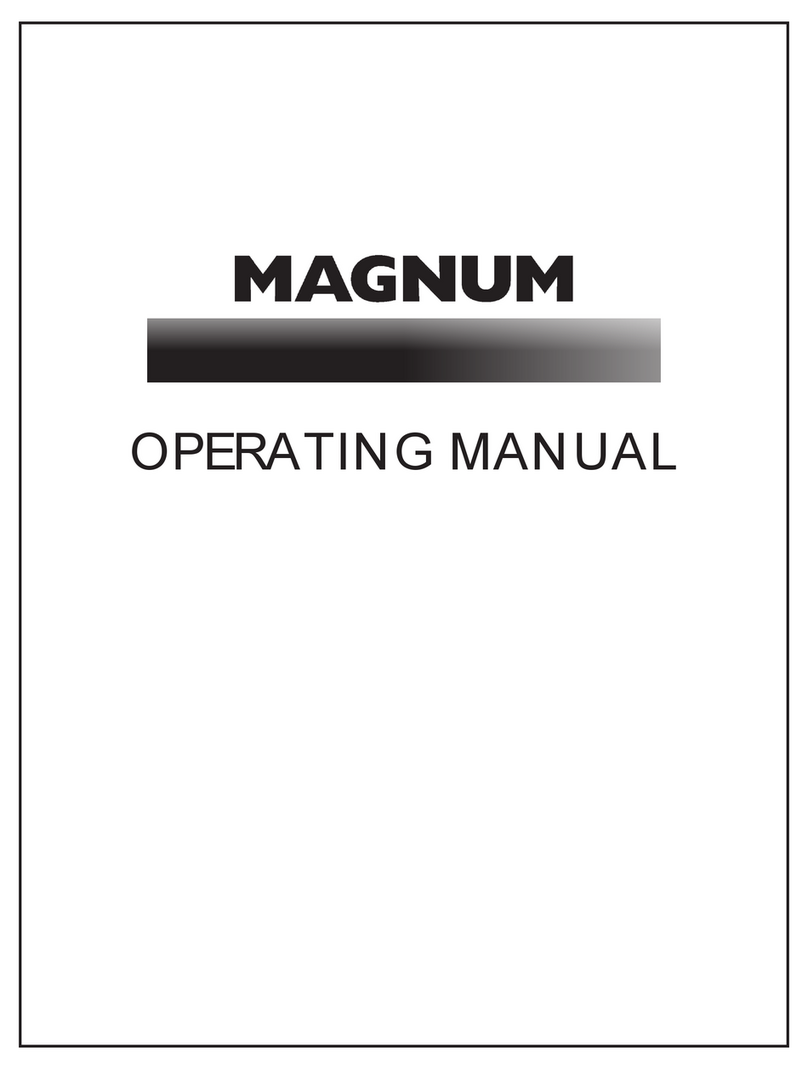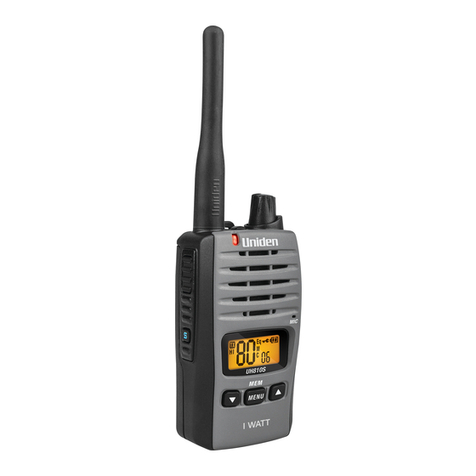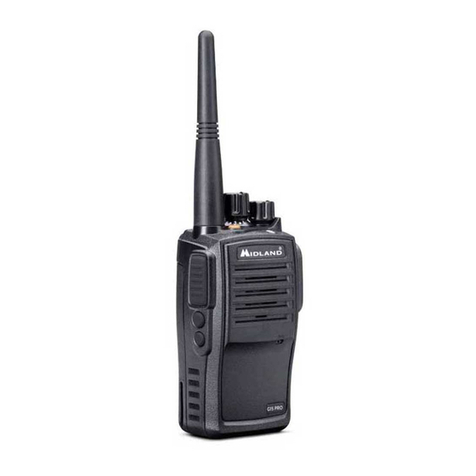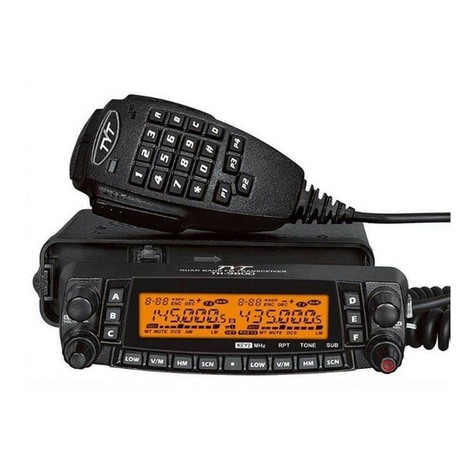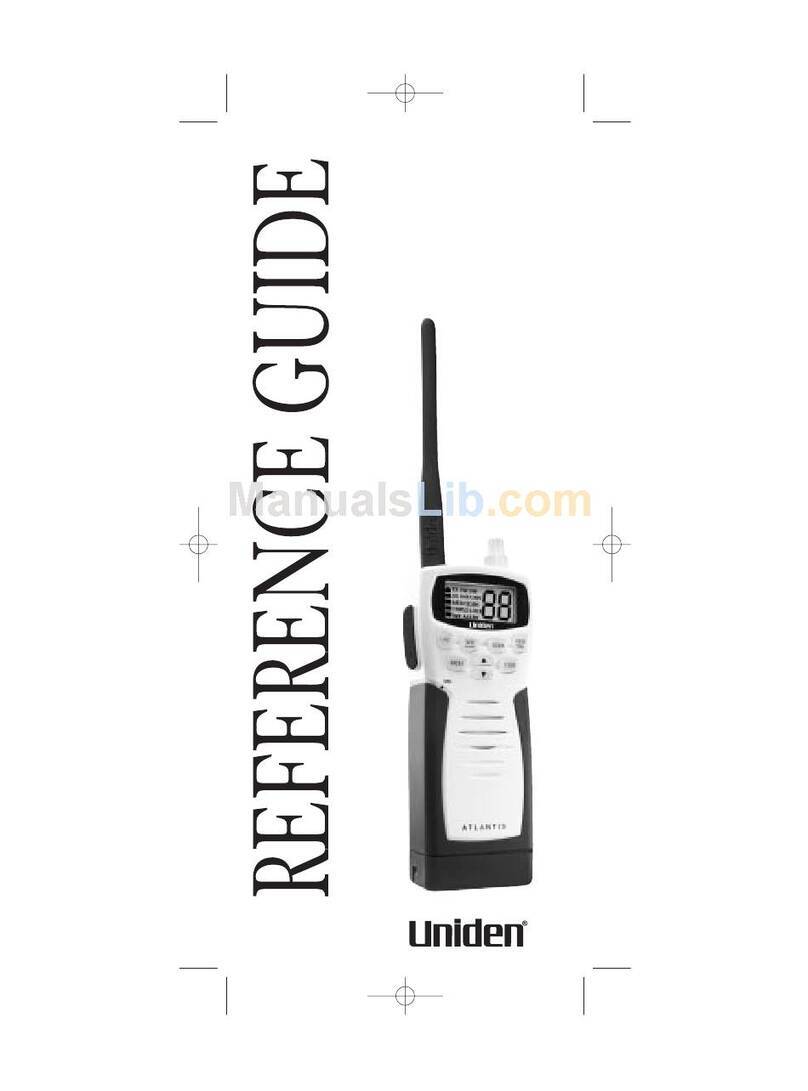Icom IC-A220 User manual

INSTALLATION GUIDE
VHF AIR BAND TRANSCEIVER
iA220 Thank you for choosing this Icom product. READ
ALL INSTRUCTIONS carefully and completely
before using this product.
Icom, Icom Inc. and Icom logo are registered trademarks of Icom Incorporated (Japan) in Japan, the United States, the United Kingdom, Germany, France, Spain,
Russia, Australia, New Zealand, and/or other countries.
qMounting bracket………………………………………… 1
wD-Sub 25 pin connector ……………………………… 1
eConnector pins (M39029/63-368)……………………… 25
rScrews Bind UNC (No. 4 × 3/8)……………………… 2
tK-Lock Nut (No. 4)……………………………………… 2
yBNC-LP ………………………………………………… 1
uWasher (Icom washer V) ……………………………… 1
iC-shaped ring …………………………………………… 1
oAntenna cable clip ……………………………………… 1
!0 Self crimping nut (No. 6) ……………………………… 1
!1 Screw (No. 6 ×1/2)……………………………………… 1
!2 Nut (No. 6) ……………………………………………… 1
!3 Crimp nuts (No. 6) ……………………………………… 6
!4 Speed nut UNC (No. 6) ………………………………… 4
!5 Screws (No. 6 ×1/2) …………………………………… 6
!6 COMM1 sticker ………………………………………… 1
!7 COMM2 sticker ………………………………………… 1
zSUPPLIED ACCESSORIES
qwer t
yuio!0 !1 !2
!3 !4 !5 !6 !7
1. Check the quantity of parts.
See zSUPPLIED ACCESSORIES.
2. Prepare miscellaneous items required for installation.
See miscellaneous items in zSUPPLIED
ACCESSORIES.
3. Prepare the required wiring.
See nCONNECTOR INFORMATION and m
CONNECTING THE CABLES FOR D-SUB 25 PIN.
• If you want to use the MBA-3 connector, see b USING
THE MBA-3 and ,CONNECTING THE CABLES FOR
CARD EDGE CONNECTOR.
4. Assemble supplied mounting bracket and other parts.
See .MOUNTING BRACKET ASSEMBLY.
5. Cut the mounting hole.
See ⁄0 MARKING A MOUNTING HOLE.
6. Mount the transceiver into the mounting bracket.
See ⁄1 MOUNTING TO THE BRACKET.
7. Check the transceiver operation.
See ⁄2 OPERATION CHECK.
xIMPORTANT
cINSTALLATION PROCEDURES
NEVER bend the cables sharply or place the cables too near
the aircraft control cables.
NEVER connect the transceiver to a power source
using reverse polarity. Reverse polarity will damage the
transceiver.
DO NOT place the transceiver where hot or cold air blows
directly on it.
DO NOT place the transceiver in areas with temperatures
below –20˚C or above +55˚C (–4˚F to +131˚F).
To prevent voltage drops, solder or crimp the cable lug when
connecting the DC power cable to the power supply.
Use a 50 Ω, vertically polarized, VHF air band antenna.
VSWR should be less than 2.5:1.
Mount the antenna on a at metal surface or install a ground
plane of at least 120 cm2(18 in2).
vPRECAUTIONS
When installing the transceiver with card edge connector, use
the optional MBA-3 as described below.
DAttachment
1. Unscrew the 10 bottom screws, then remove the
bottom cover from the transceiver.
2. Unscrew the four rear plate screws.
3.
Disconnect the I/O cable connectors J3, J4, and coaxial
J6, and then remove the rear plate from the transceiver.
Transceiver
Rear plate
J6
J4
J3
4. Connect the I/O cable connectors and coaxial onto the
MBA-3 as illustrated below.
Transceive
r
MBA-3
5. Attach the MBA-3 to the transceiver with the five rear
plate screws.
6. Replace the removed bottom cover and 10 screws.
bUSING THE MBA-3
DPower cable wiring
Use 2 pairs of #20 AWG wire for the power and power
grounding connections.
Rear view
513
14 25
1
15
4
Circuit breaker
(10 A)
+
13.8 V DC
or 27.5 V DC
Power ground
_
• Circuit breaker
To prevent physical damage, a 10 A circuit breaker MUST be
installed in the DC power line in the aircraft. Install the circuit
breaker in the aircraft breaker panel or instrument panel to
ensure easy access during ight.
• Power Ground
Connect the transceiver power ground to the aircraft ground.
DYoke-mounted memory and frequency exchange
switches
For the yoke-mounted memory and frequency exchange
switches, use a two-position spring loaded rocker switch or 2
separate momentary push switches.
Rear view
DTransmit/receive interlock connections
When 2 transceivers are installed, connect pin 2 to the
other transceiver’s PTT line, and connect pin 16 to the other
transceiver’s interlock line to prevent both transceivers from
simultaneously transmitting.
However, when 2 transceivers are installed through a dual
audio panel, the connections are not necessary.
DAudio line connections
Use #20 ~ #24 AWG wires for connections.
Rear view
113
14 25
113
14 25
910 11
16 17
18
19 20
910
16
18
19
20
12
22
23
22 23
12
PTT switch
• Connecting 1 headset
• Connecting 2 headsets with intercom
External
speaker
Intercom switch
Microphone
jack 1
Microphone
jack 2
Headphone jack 1
Headphone jack 2
PTT switch
Microphone
jack
External
speaker
Headphone jack
Audio
control
panel
Audio
control
panel
Auxiliary audio 1
Auxiliary audio 2
Auxiliary audio 3
Auxiliary audio 3
Auxiliary audio 2
Auxiliary audio 1
DGPS receiver connection
Connect the GPS receiver’s input terminal to the pin 7, and
output terminal to pin 8.
Rear view
713
14 25
8
1
GPS
receiver
GPS receiver’s input
GPS receiver’s output
mCONNECTING THE CABLES FOR D-SUB 25 PIN
DD-sub 25-pin
DCard edge connector (For optional MBA-3)
nCONNECTOR INFORMATION
Pin I/O Description Pin I/O Description
A I External Dimmer Control 1 Out RS-232C Serial data (TXD)
B – (reserved) 2 In RS-232C Serial data (RXD)
C In Auxiliary audio 2 3 In Auxiliary audio 3
D In Auxiliary audio 1 4 – Auxiliary audio 1/2/3 (GND)
E Out External speaker (4 Ω/5 W) 5 – External speaker (GND)
F – Aircraft ground 6 – Aircraft ground
H Out
Headphones audio (500 Ω/60 mW)
7 – Headphones audio (GND)
J In Microphone 1 (600 Ω) 8 – Microphone (GND)
K In Microphone 2 (600 Ω) 9 In PTT*
L In Memory channel switch* 10 In Intercom switch*
M – (reserved) 11 – (reserved)
N I Transmit/receive interlock 12 In Frequency exchange switch*
P – (reserved) 13 – (reserved)
R In DC power +(13.8/27.5 V) 14 In DC power +(13.8/27.5 V)
S – Aircraft ground 15 – Aircraft ground
*Ground to activate.
Pin I/O Description Pin I/O Description
1 In Memory Channel Switch* 14 – Aircraft ground
2 In Transmit/receive Interlock 15 – Aircraft ground
3 In Frequency Exchange Switch* 16 In PTT*
4 In DC power +(13.8/27.5 V) 17 In Intercom switch*
5 In DC power +(13.8/27.5 V) 18 Out
External speaker
(4 Ω/5 W)
6 – RS-232C Serial data (GND) 19 – External speaker (GND)
7 Out RS-232C Serial data (TXD) 20 Out
Headphones audio (500 Ω/60 mW)
8 In RS-232C Serial data (RXD) 21 In
External Dimmer control
9 – Microphone (GND) 22 –
Headphones audio
(GND)
10 In Microphone 1 (600 Ω) 23 In Auxiliary audio 3
11 In Microphone 2 (600 Ω) 24 – (reserved)
12 In Auxiliary audio 1 25 – (reserved)
13 In Auxiliary audio 2
*Ground to activate.
ABCDEFHJKLMNPRS
1234567891011 12131415
Front view
Polarizing key (user supplied)
Rear view
12345678
16 17 18 19 2014 15
91011 12 13
21 22 23 24 25
The following accessories are supplied with the transceiver.
Carefully check the quantity of each part.
The following items are required for installation but are NOT
supplied with the transceiver.
• VHF antenna for the air communication band
• Various cables
• An antenna cable with a BNC connectors (50 Ω)
• Switches to be mounted on the aircraft yoke
• Headphones. (500 Ω)
• Low-impedance carbon or dynamic microphone
• Preamplier for a dynamic microphone
D
COMM1 and COMM2 stickers
When 2 transceivers are installed, attach the supplied COMM1
and COMM2 stickers to distinguish one from the another.
COMM
COMM1 or COMM2 sticker
READ THIS INSTALLATION GUIDE CAREFULLY before
install the transceiver. This installation guide contains
important safety instructions.
NEVER install the transceiver where normal navigation of
the aircraft may be hindered.
NEVER install an antenna near any aircraft projection,
engine, or propeller.
Install a circuit breaker between the aircraft battery and the
transceiver.
Check operation after installation.
Install the transceiver according to the procedures of this
installation guide.
The antenna should be spaced at least 40 cm (1.3 feet)
from any position occupied by any person on board the
aircraft or the vehicle.
OR
113
14 25
113
14 25
Memory switch
Frequency exchange switch
Memory switch
Frequency exchange switch
3
3

A-7210D-2EX-e
Printed in Japan
© 2015–2017 Icom Inc.
1-1-32 Kamiminami, Hirano-ku, Osaka 547-0003, Japan
Printed on recycled paper with soy ink.
Check the following points after transceiver installation.
- Polarity of the power supply.
- NO interference caused to other equipment.
- NO noise or interference from other equipment.
- VSWR is less than 2.5:1.
- Communication capability on both the highest and lowest
communication frequencies, if possible.
⁄2 OPERATION CHECK
L-type BNC
connector
(User supplied, if required)
Coaxial
connector
yBNC-LP
yBNC-LP
!2 Nut
oAntenna cable clip
!0 Self-crimping nut
uWasher
iC-shaped ring
!4 Screws
!1 Screw
rScrews Bind UNC
qMounting
bracket
wD-sub 25 pin connector
!3 Crimp nut
qMounting
bracket
eConnector pins
tK-Lock Nut
.MOUNTING BRACKET ASSEMBLY
DNotes for making the mounting hole
The transceiver can be mounted securely in the supplied
mounting bracket.
Remember to allow adequate space for installation of
cables and connectors.
When installing 2 or more transceivers in a stack, the
mounting bracket should be 1.3 mm (0.05″)apart.
The mounting bracket has 0.6 mm (0.024″)dimples in the
top, bottom, and both sides for proper spacing.
Mark and cut the mounting holes.
To support the mounting bracket, the rear mounting bosses
should be attached to the airframe.
⁄0 MARKING A MOUNTING HOLE
DMounting bracket dimensions
160 mm (6.3″)
33 mm (1.3″)
260 mm (10.2 ″)
DFront panel dimensions
160 mm (6.3″)
34 mm (1.3″)
RCL
MEM
OFF
VOL
PUSH
TEST
COMM
DUAL
EC
118.00 128.10
Allow space for the front panel as shown above.
DTemplate
Cut out dimensions for the mounting bracket as follows.
160 mm (6
5
⁄
16
″)
33 mm (1
5
⁄
16
″)
DTransceiver installation
1. Remove the front panel from the transceiver’s main unit.
- Use a 3⁄32″allen driver.
- Carefully disconnect the cable from the front panel.
(Fig. 1)
2. Insert a 3⁄32″ allen driver into the lock screw and rotate
the driver counterclockwise until the metal catch
touches the back of the lock chassis. (Fig. 2)
Main unit front view
Main unit front view
3. Insert the main unit (transceiver) into the mounting
bracket. (Fig. 3)
4. Turn the lock screw clockwise until the main unit
(transceiver) is fixed to the bracket. (Fig. 4)
5. Connect the cable. (Fig. 5)
6. Attach the front panel and tighten the allen screws.
(Fig. 5)
Connect the cable. (Fig. 7)
CAUTION: Make sure that the cable between the
transceiver and front panel is securely connected. The
transceiver may not function properly when loose or when
a wrong connection is made.
Improper cable connection can cause damage and result
in severe non-warranty repair.
DTransceiver removal
The transceiver can be easily removed from the mounting
bracket, if required.
1. Remove the front panel from the transceiver's main unit.
- Use a 3⁄32″allen driver.
- Carefully disconnect the cable from the front panel.
2. Insert a 3⁄32″ allen driver into the lock screw and rotate
the driver counterclockwise until the metal catch
touches the back of the lock chassis.
3. Slowly pull the transceiver out from the mounting bracket.
4. Connect the cable to the front panel.
5. Attach the front panel and tighten the allen screws.
Fig. 1
Fig. 4
Fig. 3
Fig. 5
Fig. 1
Fig. 6Fig. 5
Fig. 7
Clockwise: For installation.
Counterclockwise: For removal.
CAUTION: Treat the cable with
care when disconnecting it.
CAUTION: Tr eat the cable
with care when connecting it.
Clockwise: For attaching.
Counterclockwise: For removal.
Cable
Fig. 2
Surface
The flat cable
Fig. 2 Fig. 4Fig. 3
Screw 4 revolutions Unscrew a quarter
revolution
• Metal catch position
Metal catch
Metal catch
⁄1 MOUNTING TO THE BRACKET
Use 2 pairs of #18 AWG wire for the power and power
connections.
Front view
AFRS
1 61415
Circuit
breaker
(10 A)
+
13.8 V DC
or 27.5 V DC
Power ground
_
• Circuit breaker
To prevent physical damage, a 10 A circuit breaker MUST be
installed in the DC power line in the aircraft. Install the circuit
breaker in the aircraft breaker panel or instrument panel to
ensure easy access during ight.
• Power Ground
Connect the transceiver power ground to the aircraft ground.
DYoke-mounted memory and frequency
exchange switches
For the yoke-mounted memory and frequency exchange
switches, use a two-position spring loaded rocker switch or 2
separate momentary push switches.
Front view
DTransmit/receive interlock connections
When 2 transceivers are installed, connect pin N to the
other transceiver’s PTT line, and connect pin 9 to the other
transceiver’s interlock line to prevent both transceivers from
simultaneously transmitting.
However, when 2 transceivers are installed through a dual
audio panel, the connections are not necessary.
Use #24 AWG wire for the connections.
AECD S
154
H
78 91015
AECD S
154
HJ
78 915
External speaker
Headphone jack 1
(to 500 ΩHeadphones)
Auxiliary audio 1
Auxiliary audio 2
Auxiliary audio 3 Audio control panel
Headphone jack 2
Microphone
jack 1
Microphone
jack 2
PTT switch
Intercom switch
External speaker
Headphone jack
Auxiliary audio 1
Auxiliary audio 2
Auxiliary audio 3 Audio control panel
Microphone
jack
PTT switch
• Connecting 2 headsets to the intercom
• Connecting 1 headset
KJ
3
DGPS receiver connection
Connect the GPS receiver’s input terminal to the pin 1, and
output terminal to pin 2.
Front view
AS
115
2
GPS
receiver
GPS receiver’s input
GPS receiver’s output
,CONNECTING THE CABLES FOR CARD EDGE CONNECTOR (MBA-3)
Memory switch
Frequency
exchange
switch
Memory switch
Frequency
exchange
switch
AS
1
L
12
15
OR
A
L
S
112
15
DPower cable wiring DAudio line connection
Other manuals for IC-A220
3
Table of contents
Other Icom Transceiver manuals
